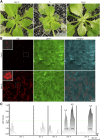Effector-Triggered Immune Response in Arabidopsis thaliana Is a Quantitative Trait
- PMID: 27412712
- PMCID: PMC5012398
- DOI: 10.1534/genetics.116.190678
Effector-Triggered Immune Response in Arabidopsis thaliana Is a Quantitative Trait
Abstract
We identified loci responsible for natural variation in Arabidopsis thaliana (Arabidopsis) responses to a bacterial pathogen virulence factor, HopAM1. HopAM1 is a type III effector protein secreted by the virulent Pseudomonas syringae strain Pto DC3000. Delivery of HopAM1 from disarmed Pseudomonas strains leads to local cell death, meristem chlorosis, or both, with varying intensities in different Arabidopsis accessions. These phenotypes are not associated with differences in bacterial growth restriction. We treated the two phenotypes as quantitative traits to identify host loci controlling responses to HopAM1. Genome-wide association (GWA) of 64 Arabidopsis accessions identified independent variants highly correlated with response to each phenotype. Quantitative trait locus (QTL) mapping in a recombinant inbred population between Bur-0 and Col-0 accessions revealed genetic linkage to regions distinct from the top GWA hits. Two major QTL associated with HopAM1-induced cell death were also associated with HopAM1-induced chlorosis. HopAM1-induced changes in Arabidopsis gene expression showed that rapid HopAM1-dependent cell death in Bur-0 is correlated with effector-triggered immune responses. Studies of the effect of mutations in known plant immune system genes showed, surprisingly, that both cell death and chlorosis phenotypes are enhanced by loss of EDS1, a regulatory hub in the plant immune-signaling network. Our results reveal complex genetic architecture for response to this particular type III virulence effector, in contrast to the typical monogenic control of cell death and disease resistance triggered by most type III effectors.
Keywords: Arabidopsis thaliana; HopAM1; Pseudomonas syringae; QTL; genetics of immunity; type III effectors.
Copyright © 2016 by the Genetics Society of America.
Figures






References
-
- Arnold D. L., Jackson R. W., Fillingham A. J., Goss S. C., Taylor J. D., et al. , 2001. Highly conserved sequences flank avirulence genes: isolation of novel avirulence genes from Pseudomonas syringae pv. pisi. Microbiology 147: 1171–1182. - PubMed
-
- Aronsson H., Boij P., Patel R., Wardle A., Töpel M., et al. , 2007. Toc64/OEP64 is not essential for the efficient import of proteins into chloroplasts in Arabidopsis thaliana. Plant J. 52: 53–68. - PubMed
MeSH terms
Substances
Grants and funding
LinkOut - more resources
Full Text Sources
Other Literature Sources
Molecular Biology Databases

